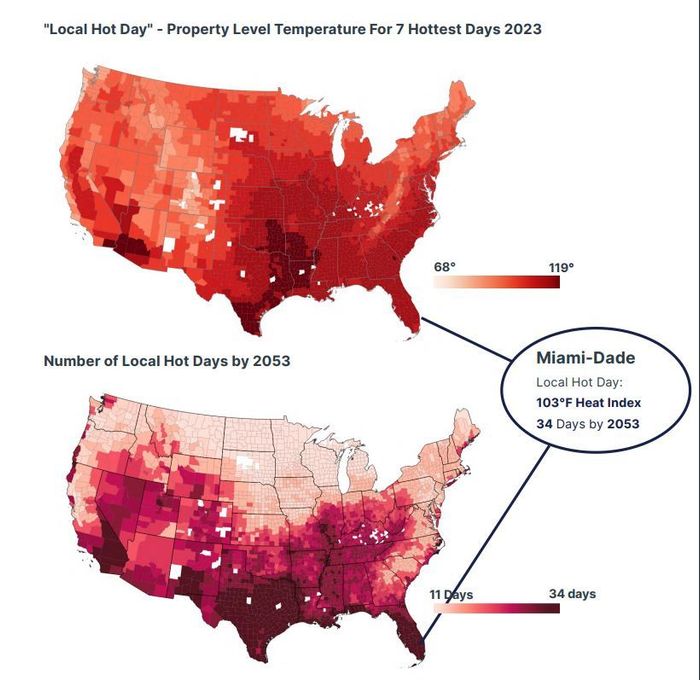Last month, just as record-setting heat waves scorched the U.K. and parts of Europe, some 60 million Americans experienced a string of hot and humid days that topped 100 degrees.
Prepare for more of these extremes.
New research and an accompanying planning tool show that across the U.S., on average, the local hottest 7 days are expected to become the hottest 18 days by 2053.
By that year, 1,023 U.S. counties are expected to exceed 125°F, an area that is home to 107.6 million Americans and covers a quarter of the U.S. land area, says nonprofit First Street.
First Street on Monday released the latest installment of a tool called Risk Factor that’s accessible free of charge, and increasingly incorporated into real estate listings, specifically through a partnership with Realtor.com.
The Brooklyn-based group first covered floods and wildfires, and with Monday’s peer-reviewed release now includes extreme heat risks. The researchers look at how the frequency, duration and intensity of extremely hot days will expand over the next 30 years from a changing climate.
Risk factors, which are searchable by property, or ZIP code or state, are meant to help homeowners, real estate agents and eventually, insurers, get a better handle on how climate change is impacting home values and the cost of homeownership. Buyers and sellers, and importantly, their real estate professional, must all ask themselvesIs if a home is priced to reflect immediate risk, such as from floods, but also the odds that property damage, energy costs or a limited ability to enjoy the outdoors might increase in coming years. And they must consider whether the home is properly insured, including accurately reflecting replacement value.
“ An emerging area, concentrated in a geographic region that First Street calls the “extreme heat belt,” stretches from the northern Texas and Louisiana borders to Illinois, Indiana, and even into Wisconsin. ”
‘Extreme heat belt’
According to First Street, the most severe shift in local temperatures is found in Miami-Dade county in Florida where the seven hottest days, currently at 103°F, will increase to 34 days at that same temperature by 2053.
What’s more, the First Street model finds 50 counties, home to 8.1 million residents, are expected to experience temperatures above 125°F in 2023, the highest level of the National Weather Services’ heat index.
Read: Severe heat: 5 electricity blackout risks facing the entire U.S., not just Texas
By 2053, 1,023 counties, about 25% of the total U.S., are expected to exceed 125°F. This emerging area, concentrated in a geographic region that First Street calls the “extreme heat belt,” stretches from the northern Texas and Louisiana borders to Illinois, Indiana, and even into Wisconsin.

First Street
“Increasing temperatures are broadly discussed in yearly averages, but the focus should be on the extension of the extreme tail events expected in a given year,” said Matthew Eby, founder and CEO of First Street Foundation. “We need to be prepared for the inevitable, that a quarter of the country will soon fall inside the extreme heat belt with temperatures exceeding 125°F and the results will be dire.”
First Street uses high-resolution measurements of land surface temperatures, tree canopy cover, impervious surfaces, land cover and proximity to water to calculate the current heat exposure, and then adjusts for future forecasted emissions scenarios. This allows for the determination of the number of days any property would be expected to experience dangerous levels of heat.
Don’t miss: Buying a home and worried about wildfires? There’s a free tool to check your risk
The model highlights the local impacts of climate change by identifying the seven hottest days expected for any property this year, and using that metric to calculate how many of those days would be experienced in 30 years.
Hotter “real feel” average temperatures have dominated headlines in recent years, making the case set out by the U.N.’s authoritative Intergovernmental Panel on Climate Change (IPCC) reports. IPCC, which calls climate change clearly human-caused and “unequivocal,” last year issued five scenarios for the future based on how much carbon emissions
CL00,
are cut and that top the more stringent of two global-warming temperature thresholds set in the 2015 Paris climate agreement.
World leaders agreed then to try to limit warming to 1.5 degrees Celsius (2.7 degrees Fahrenheit) since the late 19th century because problems mount quickly after that. The limit is only a few tenths of a degree hotter than now because the world has already warmed nearly 1.1 degrees Celsius (2 degrees Fahrenheit) in the past century and a half.
First Street experts said the population can have a hard time translating global warming predictions to actual weather changes.
“We’re talking about 125 degrees, when the joints of bridges swell, railway lines buckle and become a hazard for trains, when airplanes need extended runways to take off or sink into the tarmac because it’s so hot,” First Street’s Eby told MarketWatch. “Cement and steel will go to over 140 degrees, which would instantly burn your skin or if your dog goes outside, it would burn its paws. These are the crazy temperatures we’re talking about.”
Read: Humans are to blame for the extreme weather that broiled London — here’s just how much
Read: Flash floods, like in Las Vegas, are deadlier than hurricanes, tornadoes or lightning
Are real estate markets a better reflection of climate change?
Real estate data shows there is an emerging impact from climate-change considerations on home prices. Although it’s also true that a robust market, a jump in work-from-home options and a historically low interest-rate environment that’s begun to be reversed has underpinned a strong sellers’ market.
That means homebuyers have paid a premium for high-fire-risk and high-flood-risk homes during the pandemic, according to research from brokerage Redfin
RDFN,
This comes as more people have moved into than out of climate-risky areas in recent years, in part because they can often get more bang for their buck and gain better access to nature, the site said.
The 50 counties with the largest percentage of homes facing high fire and flood risk saw their populations increase by an average of 3% and 1.9%, respectively, from 2016 through 2020 due to positive net migration. In addition, purchases of second homes with high flood, storm and/or heat risk surged roughly 40% over the past two years.
For example, the median sale price of U.S. homes with high fire risk was $550,500 in April 2022, compared with $431,300 for homes with low fire risk, Redfin’s data shows.
Regardless of the increase in migration to climate risky areas, a Redfin survey found that 63% of people who moved during the pandemic believe climate change is or will be an issue in the place they now live.
“ ‘It’s clear that natural disasters are intensifying. Still, people are moving into risky areas.’”
Other data makes a similar case. A 2020 analysis from Realtor.com shows that home buyers are beginning to factor concerns about the changing climate into their decision-making. As a result, homes in areas vulnerable to fires, floods and extreme heat could see weaker price growth over the long haul, economists at the trade group say.
But yet another study concluded that climate-change deniers were propping up real-estate prices in waterfront communities, potentially magnifying the risks those property owners face.
“From devastating floods in Kentucky and Missouri to deadly fires in California and brutal heat waves across the U.S., it’s clear that natural disasters are intensifying. Still, people are moving into risky areas,” said Redfin Chief Economist Daryl Fairweather.
“When people decide where to live, they consider a whole host of things ahead of climate change, which has potential implications on their safety, home stability, and finances,” Fairweather said.
